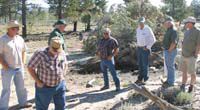| Lance Sudweeks, Randall Stilson, Commissioner Gary Kofford, Morris Sorensen, Vernell Rowley, Tom Lloyd and Ray Petersen on the field trip. |
The Emery County Public Lands Council along with the US Forest Service took a field trip to examine ongoing projects on the Manti-LaSal National Forest. The first stop on the field trip was in the Pines area where the controlled burns of the last two years were examined.
Lance Sudweeks is a range specialist with the forest service. He said the purpose of the Pines burn was to remove the built up ponderosa needles. Ponderosa’s naturally are fire tolerant. The ponderosa in the area were scorched, but it won’t bother them at all. Two or three years ago in that area a lightning strike burned through but the area did well recovering. Fire is a natural occurence. The fire burned in a mosiac pattern through the undergrowth removing many of the fallen needles. The fire was not a hot fire and didn’t burn any of the sage brush in the area. This year 1,100 acres have been burned in the Pines. Controlled burnings will take place every couple of years in this area.
Sudweeks said 10 men 80 feet apart went into the area and did the burning. Last year 1,500 acres were treated. The area will be burned again in 2009. If the results are favorable then burning will again be considered in a few years. NEPA has been completed on the whole area and burns can be conducted at the forest service’s discretion in the area.
Kevin Albrecht who is a wildlife biologist for the forest service said the environmentalists had made comments on the burn project, but hadn’t appealed it.
| A tree uprooted by subsidence. |
Sudweeks said, “Many of these trees are fire dependant for regeneration. The fire opens the pine cones and allows the seeds to establish.” He also reported the Pines area serves as winter range for elk. Cattle are allowed in the area for three months beginning June 16 and there are 1,380 AUMs in the area. Cattle and sheep allotments are now split up, but during the 60s in the area the cows and sheep all ran together.
The group also looked at the subsidence cracks from underground mining activity. A large ponderosa tree had been uprooted and fallen next to the road from the subsidence. SUFCO mine owns the coal leases under the Pines area. SUFCO has never admitted being responsible for the subsidence and the Utah Division of Oil, Gas and Mining hasn’t assigned any blame in the situation either. But, farmers and ranchers surrounding Emery have already drawn their conclusion as to the cause of the subsidence.
Steps are being taken to deal with the loss of water in the area. SUFCO has installed water guzzlers in the area for wildlife and also cattle watering troughs. They send a water truck every day to refill the troughs. A major project will be undertaken to run a waterline from White Mountain to the flats of Wildcat and the Pines. This waterline will bring water to the ponds and troughs in the area for stock and wildlife watering. SUFCO is paying for the new waterline to be installed.
A sagebrush project is also taking place in the area to regenerate sagebrush stands. The sagebrush in the Pines and Wildcat areas has not seen the die off that has been seen in other areas.
| Subsidence cracks in the Pines area. |
The group moved to an area which had been timbered and Diane Cote, from the forest service explained to the group the advantages to timbering an area.
As old growth is taken out the aspen can regenerate itself. The aspen stands are more conducive to wildlife habitat and desirable for a forest area. The fuel load in a heavily timbered area can lead to fire which damages an area and takes years to recover. Conifers overtake aspen. Fur trees are not good sources of timber, but the spruce, even the dead ones are valuable timber. Aspen stands offer a good home to a diversity of species of wildlife and grasses.
Cote said some timber projects are not economically feasible for timber companies to bid on and harvest. Sometimes the forest service has to pay someone to remove the undesirable material for them. Even trees dead four-five years still make good house logs.
Bruce Wilson, the chairman of the public lands council asked Cote how long the dead trees in the forest might stand. She said the breakdown process is very slow and it depends on the size of the trees. Many of them can stand for 60 years after their death.
The lands council also toured the area of the Jungle Burn. This prescribed burn is a fuels reduction treatment project. It’s estimated to have burned 5,500 acres, has escaped containment and is burning additional acreage.

